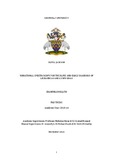JavaScript is disabled for your browser. Some features of this site may not work without it.
| dc.contributor.advisor | Stone, Nicholas | |
| dc.contributor.advisor | Bessant, Conrad | |
| dc.contributor.advisor | Rye, Adam | |
| dc.contributor.advisor | Lush, Richard | |
| dc.contributor.advisor | McCarthy, Keith | |
| dc.contributor.author | Jackson, Olivia | |
| dc.date.accessioned | 2014-08-13T13:37:22Z | |
| dc.date.available | 2014-08-13T13:37:22Z | |
| dc.date.issued | 2013-11 | |
| dc.identifier.uri | http://dspace.lib.cranfield.ac.uk/handle/1826/8641 | |
| dc.description.abstract | This thesis aimed to investigate vibrational spectroscopies for the identification of biochemical markers of leukaemias and lymphomas. In a preliminary study using the blood proteins albumin, fibrinogen and globulin, Drop Coating Deposition Raman Spectroscopy was explored and extended for use with Fourier Transform infrared spectroscopy for leukaemia blood sample analysis. Due to low sample volumes and minimal preparation required it was identified as a potential alternative to blood centrifugation to obtain the buffy coat for analysis. These studies identified that it was capable of detecting low levels of protein from small, highly concentrated droplets. Thus this method, alongside cytospin centrifugation, was used for the spectroscopic analysis of different blood fractions. Due to the low number of lymphoma samples obtained, only a feasibility study is outlined in this thesis. Samples were collected from leukaemia patients and healthy volunteers. Infrared and Raman spectra were measured of whole blood and buffy coat samples cytospun onto slides and whole blood and plasma pipetted by drop coating deposition. Multivariate statistical analysis was employed to extract key spectral differences between the pathologies and develop classification models for diagnosing chronic lymphoblastic leukaemia from previously treated and untreated patient groups. Principal component analysis followed by linear discriminant analysis was employed to identify the largest variances in the data and leave one sample out cross validation evaluated the performance of the spectral models measured on different blood components in diagnosing leukaemia. The buffy coat infrared model correctly classified 59% of the spectra, and blood droplet Raman 62%. The treated and untreated groups were then combined, which improved classification to 83% for buffy coat infrared and 71% for blood droplet Raman. These findings highlight the potential of drop coating deposition spectroscopy of whole blood for leukaemia diagnosis, although further work is required to achieve a clinically validated method. | en_UK |
| dc.language.iso | en | en_UK |
| dc.publisher | Cranfield University | en_UK |
| dc.rights | © Cranfield University, 2013. All rights reserved. No part of this publication may be reproduced without the written permission of the copyright holder. | en_UK |
| dc.title | Vibrational spectroscopy for the rapid and early diagnosis of leukaemias and lymphomas | en_UK |
| dc.type | Thesis or dissertation | en_UK |
| dc.type.qualificationlevel | Doctoral | en_UK |
| dc.type.qualificationname | PhD | en_UK |
| dc.description.notes | Lush, Richard (Clinical Supervisor) McCarthy, Keith (Clinical Supervisor) Rye, Adam (Clinical Supervisor) |
